The History of Nabataea
Dan Gibson, 2002,2022
EARLY NABATAEAN HISTORY
(300 BC - 26 BC)
For centuries, the land of Edom was the crossroads for caravans traveling north and south, and sometimes east and west. Edom and Moab were connected by a well traveled path, known as the King’s Highway. Along this road, goods from Egypt traveled to Babylon and back, and goods from southern Arabia traveled to the kingdoms in the north. This trade had existed for centuries before the Nabataeans.
The Bible tells us the story of the Queen of Sheba bringing gifts to King Solomon, including frankincense and myrrh. Immediately following these verses, the Bible tells us that King Solomon gained tremendous income from taxation. I Kings 10:14-15 records the amount as 666 talents of gold. Footnotes in the New International Version of the Bible calculate this as being around 23 metric tons of gold. Then the Bible tells us that to this total was added to the tribute paid by the Arab merchants and leaders.
Since so many caravans traveled up the King’s Highway, the land of Edom played an important role in the merchant world. Because control of the King’s Highway was so valuable, Edom was conquered by the Hebrews, the Assyrians, the Babylonians (Chaldaeans), and finally the Persians. Finally, when Alexander the Great conquered the Middle East, he brought the entire region under Greek control and he began the process of Hellenization. This was the process of bringing Greek language, thought, and culture to all the lands that were under Greek control. Upon Alexander’s death, however, his empire was divided up between his generals. The Ptolemies of Egypt and the Seleucids of Syria fought bitterly over control of the region. It was in 312 BC, early in this struggle, that the Nabataeans were suddenly catapulted onto the stage of world history.
Immediately following the dissolution of Alexander’s empire one of his generals, Antigonus The-One-Eyed, briefly rose to a position of power in Syria. He aspired to defeat his rival, Ptolemy, whose power base was in Egypt. Antigonus’ plan for success had two components: military and economic. The mountain top settlement of Selah and the Nabataean people figured in both components. By this time the Nabataeans had not only made a name for themselves as one of the principal trading powers in the region, they had also established a monopoly on bitumen which they harvested from the Dead Sea. They shipped this product to Egypt where it was essential in the embalming process. Antigonus felt that if he could gain control of the Nabataean stronghold of Selah, the hub of the major caravan routes in the region, then he would gain control over the frankincense and bitumen industry as well. This would mean that he would not only command access to and from Egypt, but he would have in his possession commodities more valuable to the Egyptians than gold.
However, Antigonus did not take into consideration the resistance that the Nabataeans would fiercely resist this plan. The historian, Diodorus Siculus, records how Antigonus dispatched his friend, Athanaeus, along with 4,000 infantry and 600 cavalry to Selah to conquer the Nabataeans and gain control of the Gaza-Sinai trade route, thus checking Egypt’s access to Syria and Arabia.
The expeditionary force reached Selah under cover of night and discovered that most of the male population was away at a market–most likely in nearby Busheira, the capital of Edom. They had left the women and children on the top of Selah mountain for protection.
The Greek army attacked and killed a number of old men, women, and children. They made off with a number of prisoners, 500 talents of silver, as well as quantities of frankincense and myrrh. Within an hour the Nabataean men had returned, taken stock of the situation, and were in hot pursuit of the invaders. Athanaeus, not believing that the Nabataeans would return so soon, had been careless in setting out guards. This proved to be a fatal mistake. He and his army were massacred. Only 50 of the cavalry were able to escape.
With their people and property recovered, the Nabataeans returned to their rock fortress and drafted a protest note to Antigonus. This set the pattern for their preferring to deal with their powerful neighbors through diplomacy rather than confrontation. Antigonus blamed the whole affair on his friend, the dead Athanaeus, whom he claimed had acted without orders. While drafting this letter, he was busily organizing a second attack, this one to be led by his son Demetrious-the-Besieger. But Antigonus had not deceived the Nabataeans. The Greek army marched for three days across the trackless desert. As soon as Nabataean spies sighted Demetrious’ troops, they set off fire signals that flashed from mountain to mountain. Being forewarned, the Nabataeans deposited what they could not carry on Selah under a strong guard. Then they gathered up their flocks and the rest of their possessions and fled into the desert. After a one-day battle, Demetrious failed to take the rocky fortress.
With their people and property recovered, the Nabataeans returned to their rock fortress and drafted a protest note to Antigonus. This set the pattern for their preferring to deal with their powerful neighbors through diplomacy rather than confrontation. Antigonus blamed the whole affair on his friend, the dead Athanaeus, whom he claimed had acted without orders. While drafting this letter, he was busily organizing a second attack, this one to be led by his son Demetrious-the-Besieger. But Antigonus had not deceived the Nabataeans. The Greek army marched for three days across the trackless desert. As soon as Nabataean spies sighted Demetrious’ troops, they set off fire signals that flashed from mountain to mountain. Being forewarned, the Nabataeans deposited what they could not carry on Selah under a strong guard. Then they gathered up their flocks and the rest of their possessions and fled into the desert. After a one-day battle, Demetrious failed to take the rocky fortress.
Antigonus was later succeeded by another of Alexander’s generals. This general, known as Seleucius, founded a dynasty that renewed and continued the struggle between Syria and Egypt for control of the region, until both were conquered by the Romans.
Around 168 BC, in the time of Judas Maccabeus, the apocryphal Book of Maccabees refers to Aretas, ruler of the Arabs (or Nabataeans as we known them today.) Aretas is known as Aretas I as no previous rulers were known to exist before that time, except perhaps someone called Rabbel I. Some time later, Josephus tells us that the people of Gaza were attacked (around 100 BC) by the Hasmonean ruler, Alexander Jannaeus. Up until this point, Gaza had acted as a principal seaport on the Mediterranean for Nabataean merchants. The people of Gaza appealed for help to Aretas II (100 - 96 BC), the ruler of the Nabataeans. Aretas, however, did not respond in time and Gaza was taken. While this may appear to be a puzzling situation, since Gaza was a very vital port in the Nabataean trading empire, Aretas II was active elsewhere. He expanded Nabataean territory to the north, which would prove to be a very prudent move. Sometime later, he seems to have negotiated a way for the Nabataean merchants to continue to use Gaza as a port city, since Alexander Jannaeus does not appear to have occupied Gaza (Philip Hammond, The Nabataeans, pg. 16). A later Roman source attributes Aretas II with 700 sons.
During the first century BC, Greek historian Diodorus of Sicily wrote about the Nabataeans. He based his work on the eyewitness account of Hieronymus of Cardia who wrote his account in the late 4th century BC when Alexander the Great’s empire was being carved up between his ambitious generals.
Diodorus describes the Nabataeans as nomads who “range over a country which is partly desert and partly waterless, though a small section of it is fruitful… Some of them raise camels, others sheep, pasturing them in the desert… they lead a life of brigandage and overrunning a large part of the neighboring territory they pillage it. Some had penetrated to the Mediterranean coast where they indulged in piracy, profitably attacking the merchant ships of Ptolemaic Egypt [presumably from Gaza].”
It is interesting to note that by the 4th century BC, the Nabataeans had moved from being merchants and pirates in the Red Sea to also operating out of ports on the Mediterranean Sea where the European powers began to experience losses to their ships. During this period, the Nabataeans either appeased or formed alliances with which ever other civilization could give them the best advantage. When necessary they would fight, but only as a last resort. Gradually they expanded their sphere of influence west into the Negev to Wadi al-Arish and beyond into Egypt where they maintained an outpost in Wadi Tumilat. Following their caravans north, they occupied many major centers on the desert route.
Obodas I was the next ruler of the Nabataeans (96-86 BC) and he continued his father’s expansion by moving on northward into Syria as Seleucid rule disintegrated. Obodas managed to ambush Alexander Jannaeus near Gadara, just southeast of the Sea of Galilee. Using a mass of camel riders, he forced Jannaeus into a deep valley where the Nabataeans completed the ambush and gained their revenge for the loss of Gaza.
Around 86 BC, Seleucid ruler Antiochus XII Dionysus mounted an invasion against Obodas I. Both Antiochus and Obodas died in battle, but the Seleucid army was utterly defeated. The Nabataean Empire was saved. Obodas was buried in the Negev, at a place that was renamed in honor: Obodat (modern Avdat). Such was his renown that it is believed that he was deified after his death.
As Seleucid rule disintegrated in the north, Aretas III (86 - 62 BC), a son of Obodas I, continued the Nabataean expansion. In 85 BC he occupied the great city of Damascus at the request of its citizens. Now Aretas III was not only the ruler of the nomadic Nabataeans but also the ruler of the world class city of Damascus. Suddenly the ‘backward’ nomadic Nabataeans were thrust onto the stage of world politics.
Aretas’ nomadic desert background was obviously a difficult issue, so to change his image from that of a nomadic desert brigand he tried to underline that he was heir to the Greek Seleucids. Aretas had coins minted with his image in the Greek style and his name in Greek instead of the Nabataean Arabic. To make his Hellenistic pretensions still clearer, he gave himself the epithet ‘Philhellene.’ The impact of these changes was so powerful that 85 BC marks the pivotal transition when Nabataeans started to rapidly move from being nomads to urban dwellers. The Nabataeans ruled Damascus for over a dozen years. Then, soon after 72 BC, the Armenian King Tigranes (son of Mithradites VI of Pontus) took Damascus and the Nabataeans retreated peacefully. Tigranes then vacated Damascus in 69 BC to deal with a Roman threat against his own capital, and the Nabataeans occupied it again, and controlled it for a number of years. We know this from the Biblical record that tells us that Damascus was under a Nabataean governor during the time of the apostle Paul (2 Corinthians 11:32-33). The death of Alexander Jannaeus’ widow Alexandra in 67 BC changed everything for the Nabataeans. Alexandra’s elder son Hyranus II was driven from his throne by his brother Aristobulus and, amazingly enough, he took refuge in the court of Aretas III at Selah. Aretas’ espousal of Hyranus’ cause soon brought the Nabataeans face to face with the rising power of Rome.
When the Roman leader Pompey annexed Syria in 64 BC, his legate Marcus Aemilius Scaurus immediately turned his attention to Judea. He was financially persuaded that a Jew by the name of Aristobulus had a claim as the Jewish high priest, so Scaurus ordered Aretas and his army to cease supporting Hyranus II and return to Selah. Aretas did so, unwilling to risk his troops and his country for the sake of Hyranus. Scaurus returned to Syria with his bribe, but Aristobulus, not content with this bloodless victory, pursued the Nabataeans and defeated them with the loss of 600 lives.
Pompey had planned to move against the Nabataeans, but the continuing feud among the Jewish rulers deflected his attention away. In 63 BC Pompey personally took control of Jerusalem and sent Aristobulus and his family (the Jewish high priest) to Rome in chains. Hyranus was then confirmed as high priest and ethnarch, but was denied the title of king.
Having settled the issues in Judea, Pompey finally turned his attention to the wealthy Nabataeans. He dispatched Aemilius Scaurus to campaign against the Nabataeans, which meant his armies marched through a dry and desert land. His army suffered from hunger, thirst, and exhaustion. The expedition was called off at the last moment when a rider appeared reporting to the Romans of the murder of Mithradites VI, the king of Armenia, by his son Tigranes. Pompey immediately wanted to disengage from the Nabataeans to deal with this last vestige of the Pontic threat. The wily Nabataeans seized the opportunity and offered the Romans 300 talents of silver if they would leave. Pompey accepted and in doing so set a tempting precedent for later Roman generals who wished to improve their personal finances.
Around 62 BC, a second Obodas seems to have become a Nabataean ruler, as evidenced by a handful of coins.
His successor, Malichus I (59 - 30 BC) played a dangerous game of politics in the hectic years that saw Rome transition from a republic to an empire. He judged rightly by backing Julius Caesar against Pompey. In order to prove their alliance, in 47 BC, Malichus I honored a request from Julius Caesar to provide him with 2000 cavalry during the Roman dictator’s Alexandrian campaign.
Afterward, Malichus mis-stepped by joining Caesar’s assassins and their Parthian allies against Antony and Octavian. However, with a skillful blend of wealth and diplomacy emulating that of his predecessors, he was able to buy his kingdom out of subjugation to Rome.
When Antony was given the eastern areas of Rome’s dominions, the opportunistic Cleopatra demanded as a gift both Judea (a dependency ruled by Herod the Great) and the still independent kingdom of the Nabataeans, who were now considered allies of Rome.
Despite Antony’s infatuation, it was one of the few of Cleopatra’s many requests that Antony turned down, though he may have given her a strip of Nabataean land by the Red Sea. Antony was later defeated by Octavian (soon to be known as Emperor Augustus) at the Battle of Actium in 31 BC, and he and Cleopatra ended their lives with suicide. This left the Nabataeans to be their own masters.
Obodas III became the ruler of the Nabataeans in 30 BC and ruled until 9 BC. Strabo’s Geography, written in the early 1st century AD, describes Nabataean life under Obodas III:
“The Nabataeans are a sensible people, and are so much inclined to acquire possessions that they publicly fine anyone who has diminished them, and also confer honors on anyone who has increased them. Since they have but few slaves, they are served by their kinsfolk for the most part, or by one another, or by themselves, so that the custom extends even to their ruler. They prepare common meals together in groups of thirteen persons, and they have two girl-singers for each banquet. Their leader holds many drinking-bouts in magnificent style, but no one drinks more than eleven cupfuls, each time using a different golden cup. The ruler is so democratic that, in addition to serving himself, he sometimes even serves the others in his turn. He often renders an account of his leadership in the popular assembly, and sometimes his method of life is examined.”
Strabo reveals how the Nabataeans had changed in the intervening years. Strabo’s information came from his friend Athenodorus, a Stoic philosopher, tutor of Caesar Augustus, and a native of Petra. These excerpts from Strabo’s Geography describe Petra approaching the zenith of its power:
“The capital of the Nabataeans is called Petra. It is situated on a spot which is surrounded and fortified by a smooth and level rock, which externally is abrupt and precipitous, but within there are abundant springs of water both for domestic purposes and for watering gardens. Beyond the city-enclosure, the country is for the most part a desert. Athenodorus … used to relate with surprise that he found many Romans and also many other strangers residing there … frequently engaged in litigation, both with one another and with the natives; but that the natives had never any dispute amongst themselves, and lived together in perfect harmony… A great part of the country is fertile and produces everything except oil of olives. Instead of it they use the oil of sesame.”
On the other hand, Strabo didn’t think much of the Nabataean military. He mentions that the Nabataeans “are not very good warriors on land, rather being hucksters and merchants, not like their fighting at sea.” One can infer from Strabo that the Nabataeans were not only known as desert dwellers and rascals but also as seamen.
Strabo adds that Obodas did not care much about public and military affairs. He seems to have given much of his authority to his very active minister, Syllaeus, who some believe may well have been responsible for later poisoning him.
MIDDLE NABATAEAN HISTORY
(26 BC - 40 AD)
Whenever tourists visit ancient Roman city sites they are struck with the large number of temples that the Romans built. As the Romans worshiped a pantheon of gods, they were constrained to build temples to these gods wherever they went. As their empire expanded, the number of temples expanded. Each of these temples burned incense. Added to this, incense and myrrh were used at funerals to mask the odor of death. All of this eventually led to a massive demand for incense, which the Nabataeans were not only striving to exploit and fulfill, but also striving to monopolize.
As a result, great amounts of money were leaving the Roman coffers and being passed on to the Nabataeans. It became so bad that in 26 BC, Agustus Caesar sent an army under the command of the proconsul of Egypt, Aelius Gallus, to discover the lands south of Egypt to see if there was a land route to southern Yemen, the origin of frankincense. The expedition traveled south from Egypt to explore Troglodytae, or present day Djibouti.
Strabo tells us: “Augustus Caesar dispatched this general to explore the nature of these places and their inhabitants, as well as those of Ethiopia, for he observed that Troglodytica, which is contiguous to Egypt, bordered upon Ethiopia; and that the Arabian Gulf was extremely narrow where it separates the Arabians from the Troglodytae. It was his intention either to conciliate or subdue the Arabians. He was also influenced by the report which had prevailed from all time, that this people were very wealthy, and exchanged their aromatics and precious stones for silver and gold, but never expended with foreigners any part of what they received in exchange. He hoped to acquire either opulent friends, or to overcome opulent enemies.” (Geography XVI.4.23)
After the first expedition, Augustus Caesar encouraged Aelius Gallus to employ the Nabataeans as guides and escorts on an expedition down the Arabian side of the Red Sea to locate the source of frankincense. You can imagine the predicament this was for the Nabataeans. The Nabataeans were deemed allies of Rome, but if the Romans discovered their source of frankincense, then the Romans would simply sail down the Red Sea and buy directly from the South Arabian kingdoms, thus excluding the Nabataeans from their lucrative trade.
It appears that Syllaeus, the chief minister of Obodas II, had a clever solution to the problem. He agreed to lead the expedition, and together with a contingent of Nabataean camel cavalry, took his place at the head of the Roman Army with the Roman General Aelius Gallus. First, however, the Roman Army needed to get from Egypt to Arabia. The Romans decided to build a fleet of boats for this purpose.
Strabo tells the story this way:
“He (Aelius Gallus) was, moreover, encouraged to undertake this enterprise by the expectation of assistance from the Nabataeans, who promised to cooperate with him in everything. Upon these inducements Gallus set out on the expedition. But he was deceived by Syllaeus, the king’s minister of the Nabataeans, who had promised to be his guide on march, and to assist him in the execution of his design. Syllaeus was, however, treacherous throughout; for he neither guided them by a safe course by sea along the coast, nor by a safe road for the army as he promised, but exposed both fleet and the army to danger by directing them where there was no road, or the road was impracticable, where they were obliged to make long circuits, or to pass through tracts of country destitute of everything; he led the fleet along a rocky coast without harbors, or to places abounding with rocks concealed under water, or with shallows. In places of this description particularly, the flowing and ebbing of the tide did them the most harm.
The first mistake consisted in building long vessels of war at a time when there was no war, nor any likely to occur at sea. For the Arabians, being mostly engaged in traffic and commerce, are not a very warlike people even on land, much less so at sea. Gallus, notwithstanding, built not less than eighty biremes and triremes and galleys at Cleopatris, also called Arsino’, and near Hero’polis, near the old canal which leads from the Nile.
When he discovered his mistake, he constructed a hundred and thirty vessels of burden, in which he embarked with about ten thousand infantry, collected from Egypt, consisting of Romans and allies, among whom were five hundred Jews and a thousand Nabataeans, under the command of Syllaeus. After enduring great hardships and distress, he arrived on the fifteenth day at Leuce-Come, a large mart in the territory of the Nabataeans, with the loss of many of his vessels, some with all their crews, in consequence of the difficulty of the navigation, but by no opposition from an enemy.
These misfortunes were occasioned by the perfidy of Syllaeus, who insisted that there was no road for an army by land to Leuce-Come, to which and from which place the camel traders travel with ease and in safety from Selah, and back to Selah, with so large a body of men and camels as to differ in no respect from an army.” (XVI.iv.24) After landing the army, with the loss of men and ships, they headed inland, and south towards southern Arabia. Then things got worse.
“Gallus, however, arrived at Leuce-Come, with the army laboring under stomacacce and scelotyrbe, diseases of the country, the former affecting the mouth, the other the legs, with a kind of paralysis, caused by the water and the plants (which the soldiers had used in their food). He was therefore compelled to pass the summer and the winter there, for the recovery of the sick.“
The following spring they set out again. Strabo tells the story:
“Gallus, setting out again from Leuce-Come on his return with his army, and through the treachery of his guide, traversed such tracts of country, that the army was obliged to carry water with them upon camels. After a march of many days, therefore, he came to the territory of Aretas (modern Medina?) , who was related to Obodas. Aretas received him in a friendly manner, and offered presents. But by the treachery of Syllaeus, Gallus was conducted by a difficult road through the country; for he occupied thirty days in passing through it. It afforded barley, a few palm trees, and butter instead of oil
The next country to which he came belonged to the nomads, and was in great part a complete desert (the Debae). It was called Ararene. The king of the country was Sabos. Gallus spent fifty days in passing through this territory, for want of roads, and came to a city of the Nejrani (probably Mecca), and to a fertile country peacefully disposed. The king had fled, and the city was taken at the first onset. After a march of six days from thence, he came to the river (in the land of the Minae).
Here the barbarians attacked the Romans, and lost about ten thousand men; the Romans lost only two men. For the barbarians were entirely inexperienced in war, and used their weapons unskillfully, which were bows, spears, swords, and slings; but the greater part of them wielded a double-edged axe. Immediately afterwards he took the city called Asca (probably modern Al-Lith), which had been abandoned by the king. He thence came to a city Athrula (modern Abha?), and took it without resistance; having placed a garrison there, and collected provisions for the march, consisting of grain and dates he proceeded to a city Marsiaba, belonging to the nation of the Rhammanitae, who were subjects of Ilasarus (in modern Yemen, east of modern San’a). He assaulted and besieged it for six days, but raised the siege in consequence of a scarcity of water. He was two days’ march from the aromatic regions, as he was informed by his prisoners.
He occupied in his marches a period of six months, in consequence of the treachery of his guides. This he discovered when he was returning; and although he was late in discovering the design against him, he had time to take another route back; for he arrived in nine days at Negrana (near modern Sa’dah?), where the battle was fought, and thence in eleven days he came to the “Seven Wells” (modern Al-Qunfudhah), as the place is called from the fact of their existing there. Thence he marched through a desert country, and came to Chaalla, a village, and then to another called Malothas (perhaps modern Jeddah), situated on a river. This road then lay through a desert country, which had only a few watering-places, as far as Egra (modern Yanbu) a village. It belongs to the territory of Obodus, and is situated upon the sea.
He accomplished on his return the whole distance in sixty days, in which, on his first journey, he had consumed six months. From Negra he conducted his army in eleven days to Myus Hormus; thence across the country to Coptus, and arrived at Alexandria with so much of his army as could be saved.
The remainder he lost, not by the enemy, but by disease, fatigue, famine, and marches through bad roads; for seven men only perished in battle. For these reasons this expedition contributed little in extending our knowledge of the country. It was however of some small service. Syllaeus, the author of these disasters, was punished for his treachery at Rome. He affected friendship, but he was convicted of other offences, besides perfidy in this instance and was beheaded. (actually he was killed by throwing him from a cliff)” (XVI.iv.25)
Gallus accused Syllaeus of treachery, charging that the Nabataean minister had deliberately led the Romans across the most arid and desolate land he could find, using the most round about route he could think of. The route the army took, however, was an established trade route; although it was one that the Nabataeans seldom used as in those days they preferred the maritime route. Syllaeus managed to peacefully get away from the Romans and return to Petra a hero. Along with defeating the Roman Army, he had used the Roman army to weaken the South Arabian kingdom of Saba allowing the Himyarites, the kingdom friendliest to the Nabataeans, to overcome them later that year (25 BC).
Obodas confirmed Syllaeus as chief minister and almost immediately, Syllaeus initiated negotiations with both the Romans and Herod the Great, a long-time foe of Nabataea. Some think Syllaeus was setting himself up to be the next king.
Obodas was assassinated in 9 BC, possibly poisoned by Syllaeus. A short time later Syllaeus found himself in shackles, and was transported to Rome. He was tried for the murder of Obodas by a Roman court, found guilty, and pitched headlong from the Tarpeian Rock in 6 BC.
In brief, the conflict developed as follows: in 12 BC, while Herod had been absent, the Nabataeans encouraged the inhabitants of Trachonitis, who were under Herod’s rule, to revert to brigandage, and had given asylum to forty of their ‘bandit chiefs.’ Using a base provided for them in Nabataean territory, they raided not only Judea, but pressed into the province of Syria, and quite possibly the cities of the Decapolis. Herod could and did repress those in Trachonitis, but he could do little about those operating out of Nabataean territory. He appealed to the governors of Caesar, Saturninus, Volumnius, and Sentius Saturninus and the procurator of the province. No question of Roman military interception seems to have arisen. They merely decided that the Nabataeans would pay a debt due to Herod and that refugees on both sides should be restored. Only when this was not done did the Romans give Herod permission to invade Nabataea. After a successful invasion and a minor battle, Herod settled a colony of three thousand Idumaeans to control Trachonitis, and wrote to the Roman officials explaining his actions.
The affair was further complicated by the death of Obodas, the king of Nabataea, and the accession of Areneas, without Augustus’ permission. The Romans considered the Nabataeans allies and perhaps subjects of Rome. The Nabataeans considered themselves subject to no one.
Areneas then changed his name to the kinglier “Aretas.” Unlike Aretas II, who had looked abroad for his epithet ‘Philhellene,’ Aretas IV called himself ‘rym ‘mh’ or ‘he who loves his people.’ During his long reign (9 BC - 40 AD) the Nabataeans reached the height of their economic and cultural development. They built new towns and enlarged and embellished old ones. In particular, most of the major monuments at Petra were built during this time. They also extended their irrigation schemes and expanded their agricultural base.
Some writers have felt that an attractive feature of the Nabataeans at this time was the status they accorded women. Inscriptions at Meda’in Saleh in Saudi Arabia indicate that Nabataean women, unlike many of their contemporaries, inherited and owned property in their own right. Also, from the time of the democratic Obodas II onwards, the queen’s profile appears on coins together with that of her husband or in the case of a regency, her son. Aretas IV seems to have had two wives, apparently successively rather than together. The first wife was called Huldu, and the second Shaqilath. Another Shaqilath appears as the consort of his successor Laichus II, and again with her son, the last Nabataean king, Rabbel II during his minority.
There had long been ties between Herod the Great and the Nabataeans. Herod was the son of an Idumean (Edomite) father and a Nabataean mother. It seems he spent part of his boyhood in Petra. When Herod was forced to flee Jerusalem and sought to secure help from Rome, he is said to have attempted to find asylum in Petra but was repulsed by the king of the Nabataeans. Later, when Herod received the kingship of the Jewish State from the Roman Senate and returned to Jerusalem, various political relations existed between him and the Nabataeans. However, as the Nabataeans continued to expand their sphere of influence, skirmishes soon began to take place along their common border. In an attempt to end the fighting, Aretas IV married one of his daughters, Phasaelis, to Herod Antipas, a son of Herod the Great. When Herod the Great died in AD 4, his kingdom was divided between his three sons who had escaped his recurrent murderous moods. In 6 AD, Rome annexed Herod the Great’s realm and created the Province of Judea.
Herod Antipas became the tetrarch of Galilee and Paraea. For a while this resulted in good relations, but in AD 27, Antipas fell passionately in love with his niece. Her name was Herodias, and she was the mother of Salome and the wife of Antipas’ brother, Herod Philip. To marry her, which outraged religious opinion, he divorced his Nabataean wife, which outraged Aretas. John the Baptist’s outspoken condemnation of the marriage and his subsequent imprisonment and execution at the instigation of the delinquent Herodias are well known. Less well known is that the spurned Nabataean wife went quietly home to Petra and Aretas launched an expedition against his old son-in-law and new enemy.
Aretas IV assembled an army and defeated Herod Antipas’ army, but the Nabataean king was unable to do more. The Romans decided to come to Herod’s defense to defend his honor, and the honor of the Empire.
Some historians feel that during a brief revival of Nabataean rule in Damascus under Aretas IV, the apostle Paul made his famously undignified exit from the city. The Bible tells us that this was when “*the governor under King Aretas guarded the city… in order to seize me, but I was let down in a basket through a window in the wall and escaped his hands*” (2 Corinthians 11:32-33).
LATE NABATAEAN HISTORY
(40 AD - 600 AD)
Damascus was finally lost to the Nabataeans under Malichus II son of Aretas IV (40 -70 AD). Little is known of him, but according to Josephus, he sent Emperor Titus 1000 cavalry and 5000 infantry which took part in the destruction of Jerusalem in AD 70.
In that same year, Rabbel II, the last of the Nabataean rulers came to the throne. Rabbel II was a minor and his mother Shaqilath acted as his regent for six years. Rabbel, who seems to have preferred the city of Bostra in the north of his kingdom, was known as ‘hyy wsyzb ‘mh’ or ‘he who brings life and deliverance to his people.’ Some feel this refers to his putting down a rebellion in Saudi Arabia. During Rabbel’s reign, the kingdom enjoyed a period of peace and prosperity. However, it was the final decades of the Nabataean kingdom before Rome took over.
At the height of its power, Nabataea stretched from Damascus southward into northern Arabia. It was bordered on the west by the Roman-held lands comprised of Judea, Samaria, Galilee, Paraea, and the Decapolis and by Egypt. The Nabataeans’ eastern border, being in the desert, was undefined but could be said to stretch to the borders of Parthia. Thanks to the extraordinary Nabataean genius for water management, their agriculture flourished in the desert. Their trading empire, dealing in luxury goods, linked the Mediterranean world with China, India, Parthia, and Arabia.
Rabbel II disappeared from the scene in AD 106 when the Roman legate of Syria, Corelius Palma, annexed the Nabataean kingdom on behalf of the Emperor Trajan, and incorporated it as the new Province of Arabia. While historical records have not yet been discovered that describe this takeover, it is interesting to notice that after 106 AD the Nabataeans continued as a distinct people within the Empire and even enjoyed a period of economic prosperity in the later Byzantine era. Right after the Roman takeover, coins were minted referring to “Arabia adquista’ or the acquired, not captured, Arabia. Under the Romans Claudius Severus built a new paved road which eventually linked the northern city of Bostra with the Red Sea port of Aila (Aqaba) in the south. The road was some 500 kilometers in length, and was known as the Via Nova Traiana. It was completed in 114 AD and followed much the same path as the ancient caravan routes and the King’s Highway. Now troops as well as items of trade could be moved speedily from one place to another.
It is unclear if Petra was the capital of the Province of Arabia in its early years. The role was certainly passed to Bostra, which Trajan rebuilt and named after himself, Nea Traiane Bostra. Petra certainly was still of great eminence and was an important administrative center as it was the only city in the province to which Trajan gave the title ‘metropolis.’ However, it was Hadrian, who visited Petra in 130 AD on his grand tour of the eastern Roman Empire, who gave the city his name, Petra Hadriane.
Many years later in 260 AD, the Sassanid Persians attacked the province of Syria and captured Antioch, taking the Emperor Galerian prisoner. The now rich and powerful Arab kingdom of Palmyra came to Rome’s help and repelled the Persian invasion. This move placed the Palmyrans in the role as Rome’s ally and buffer against the east, just as the Nabataeans had once been in the south.
The city of Petra flourished for at least a century more, thanks to her citizens who continued trade and agriculture. However, by the mid 3rd century AD, with the economy of the whole region under pressure, the city began a slow and irrecoverable decline. The Emperor Diocletian briefly checked the slide of the Roman provinces at the end of the third century by political reorganization, enlargement of the army, and re-fortifying of the provinces. The northern half of the Province of Arabia retained its name, but the south, including Petra and the lands below Wadi Hisa, became part of the Province of Palestine: Palestina Tertia.
Byzantine Petra
In 330 AD, Emperor Constantine the Great transferred the capital of the Roman Empire to the Greek city of Byzantium and rebuilt and gloriously embellished it. In 313 AD, Christianity was proclaimed the official religion of the empire, and Constantine formally dedicated his capital, New Rome (Constantinople) on May 11, 330. The Nabataeans and Petra in particular had already had its Christian martyrs during the persecution of Diocletian. These thought provoking examples must have had the de-Christianizing effect Diocletian desired, for very soon afterwards the Christian chronicler Eusebius thundered against Petra for being filled with superstitious men who have sunk in diabolical error. However, churches were already being built there.
In the mid-4th century Bishop Asterius of Petra is named as a participant in the Arian controversy, that long and bitter dispute over whether Christ was of one nature with the Father, or merely shared a similar nature. Asterius started as an Arian but ended up on the orthodox side. For this he was banished by the pro-Arian Emperor Constantius, but later recalled by the more tolerant Julian the Apostate.
Pagan worship continued in the Nabataean areas, side by side with Christianity, for a number of years. During this time a certain monk called Mar Sauma felt called upon to rectify this situation, so he and his forty brother monks, who were traveling around the Empire destroying pagan temples, arrived in Petra in 423 AD to find the gates shut fast against them. Their demands to be let in, accompanied by threats of attack if they were not, coincided with a rainstorm of such intensity that part of the city wall was broken, and the monks managed to enter. The whole episode was deemed to be of truly miraculous significance as there had been an unbroken drought for four years and some of the impressed pagan priests duly converted to Christianity.
Over the following century or so, bishops from Petra took part in the various councils of the Church, convened to discuss the series of doctrinal disagreements which followed the Arian controversy with dizzying frequency. Petra also seems to have become a place of exile for troublesome or heretical priests, prelates, or prominent laymen who failed to agree with the Emperor or with the decisions of these councils. The most famous such exile, according to one contemporary document, was Nestorius, one of the promoters of the Nestorian heresy, which was condemned at the Council of Ephesus in 431. The city must have been in a prophetically lamentable condition by then, well chosen for those sentenced to contemplate the error of their ways, for an earthquake on 19 May 363 had destroyed more of the city, and economic slide and decline continued after. It was during this time in the 4th Century AD that the Urn Tomb in Petra was transformed into a church, while the pagan temples continued to thrive in the center of the city..
In the early 1990s, archeologists uncovered the remnants of a Byzantine era church in Petra with intact mosaics and 50 letters written in Greek, known as the Petra Scrolls. The last reference to a resident bishop is to Athenogenus, a nephew of Emperor Maurice (582-602).
Coin evidence from around the Colonnade Street shows that shops in the center of the city were still in use during the fourth century, but commercial activity had largely ceased by the end of the fifth century.
A fourth century Syriac letter, attributed to Bishop Cyril of Jerusalem, discusses major earthquake destruction at Petra on May 19, 363, but the city continued to function after that.
During the fifth and sixth centuries, most of the forts that formed the Roman-Byzantine security belt east of Petra were abandoned and the area came under the control of the Ghassanids, a client tribe of the Byzantines. On 9 July 551, another devastating earthquake struck much of Petra to heaps of rubble. The citizens dug through the rubble to collect idols and holy items and gathered them into the center of the city, placing them around the ancient Altar of Abraham in front of the monument known today as Qasr al Bint. It is in this setting that the story of Islam starts. This can be found under the heading: The Founding of Islam.








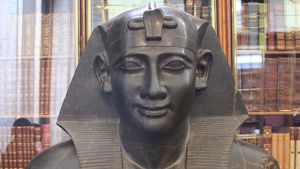
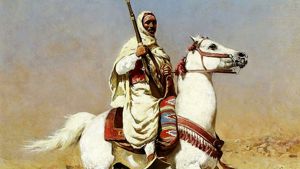



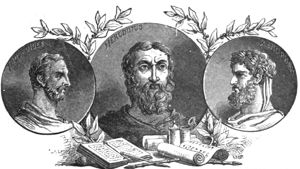


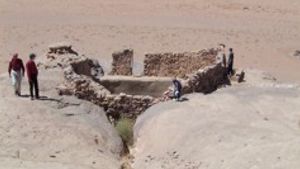
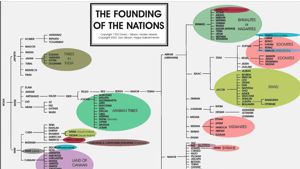
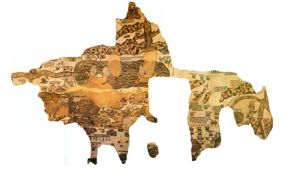
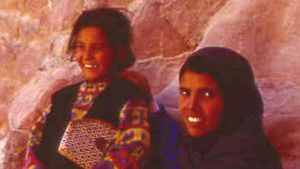
Page Discussion
Membership is required to comment. Membership is free of charge and available to everyone over the age of 16. Just click SignUp, or make a comment below. You will need a user name and a password. The system will automatically send a code to your email address. It should arrive in a few minutes. Enter the code, and you are finished.
Members who post adverts or use inappropriate language or make disrespectful comments will have their membership removed and be barred from the site. By becoming a member you agree to our Terms of Use and our Privacy, Cookies & Ad Policies. Remember that we will never, under any circumstances, sell or give your email address or private information to anyone unless required by law. Please keep your comments on topic. Thanks!